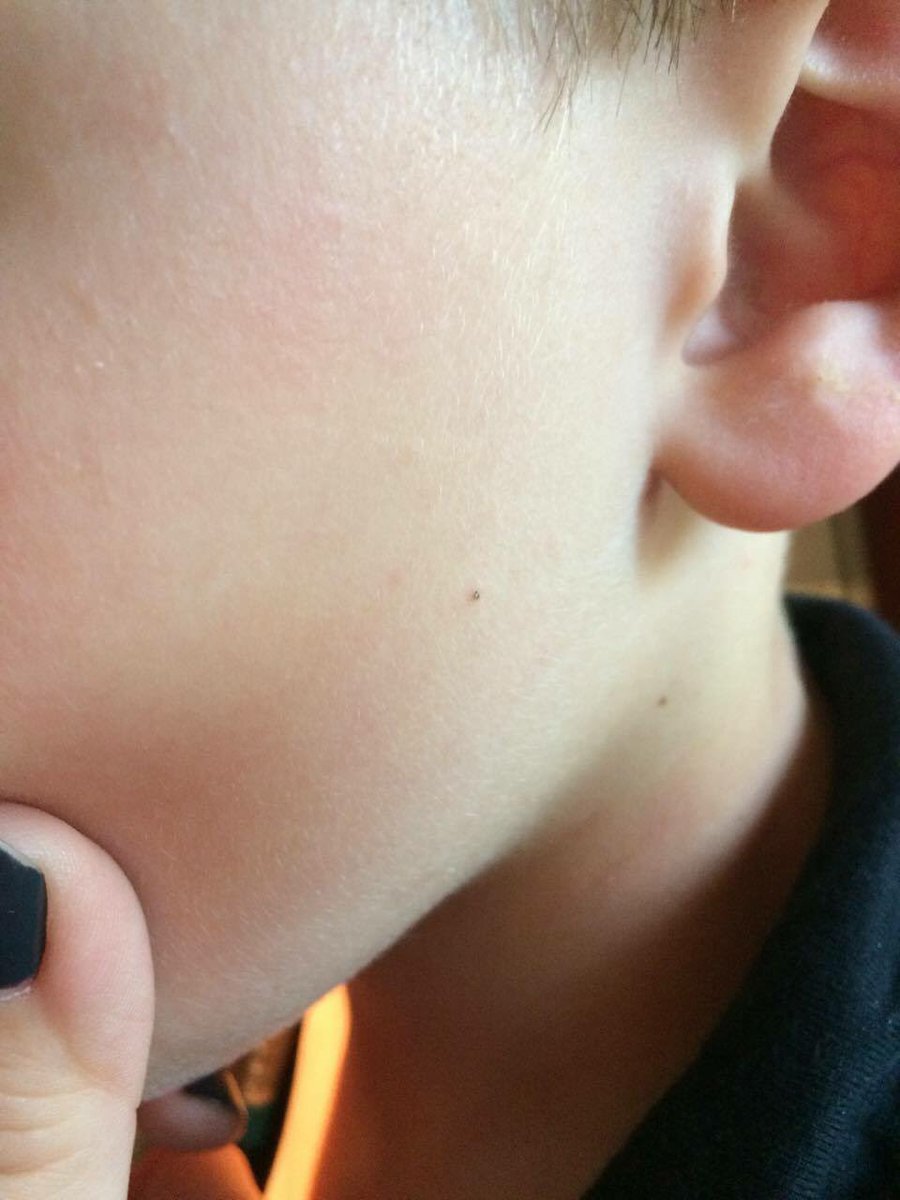Tick removal
Even better than tick removal is to AVOID allowing ticks to attach in the first place. Wearing long pants and sleeves, and walking with a friend who can keep an eye on your back means that you have time to see the tick and brush it off before it attaches.

Keep switching positions of who is in back if walking single file. Look frequently for signs of ticks on you or your friend. If you find an attached tick, safely remove the tick as completely and as quickly as possible without squeezing the body of the tick which can inoculate you with whatever disease may be in the gut of the tick.
It is hard to see ticks that are attached. Look at photo to the right, spot the ticks attached to this child’s face. One is the dark freckle on the cheek and the other freckle on the neck……….>>>
As described in the Transmission section, ticks in the larval or nymphal stage of development acquire the Lyme disease bacterium (Borrelia burgdorferi) by feeding on the blood of an infected host although we now know we not only have Borrelia burgdorferi in our ticks to cause borreliosis (Lyme disease) in humans, we also have other strains and species such as Borrelia miyamotoi, Borrelia hermsii, etc.
With the recently discovered Borrelia miyamotoi, for example, the mother tick can pass the infection to the egg which in turn can pass it to the larvae, on to the nymph and adult. Larvae hatch in the thousands so if you encounter these you may be at risk, and unfortunately they are not much bigger than the period at the end of this sentence making them very hard to detect. One good thing is that, unlike mosquitoes (which can attach and begin feeding within seconds of landing on you) ticks take much more time to crawl to a suitable spot on your body, bite into your skin, secrete a ‘cement’ that secures them in place, and begin feeding/salivation.
Now though, we must revisit all this research done on Borrelia burgdorferi, to see if species/strains such as Borrelia miyamotoi follow the same rules now that we already know Borrelia miyamotoi broke the rule about mother tick not being able to pass the bacteria to their eggs. We have to revisit everything such as, does it take hours before the tick can transmit the disease to you, and if mosquitos can transmit it. Mosquitos have been shown to carry Borrelia burgdorferi in their gut, but have not been shown to successfully transmit it but does that hold true for all Borrelia species/strains.
The safest rule as regards to how long it takes a tick to transmit a borreliosis to you is, ‘the sooner you remove the tick the greater the chance of preventing infection’. This is one reason why checking over your body carefully at the end of a long walk in the woods, then showering using a facecloth and back scrubber to scrub the body is usually sufficient to avoid infection even if the tick has already attached because ticks can be brushed off easily if not yet fully attached.
The following tick removal methods are NOT recommended:
- Burning the tick off with a match or cigarette lighter
- “Suffocating” the tick with petroleum jelly or oils
- Gripping the tick with thumb and forefinger and tugging at it
Safe tick removal methods
Method 1: Tick-Removal Tool/Kit … Order our Tick Removal Kit for Proper Removal
If you already have a pair of fine pointed tweezers, and a steady hand, you can grasp the mouthparts of the tick, NOT the body of the tick, and slowly pull the tick straight out.
https://www.youtube.com/embed/AmM5NmQMHVo
Watch tick removal video.
Remember that the skin may be swollen around the site of the tick attachment so if you’re not sure what you’re doing, you may prefer to use a specially designed tool. Our Tick Kits contain three types of tick remover tools.
Method 2: Straw and Knot
The ‘straw and knot’ method is an elegant, easy, effective, low technology tick removal method.
Camping and hiking are high-risk activities for encountering ticks, so remember to pack a straw and thread (or thin dental floss) next time you head into the woods.
- Place an ordinary drinking straw at a 45-degree angle over the tick. (The straw is simply being used as a guide to direct the knot).
- Take a length of thread (or dental floss) and tie a loose knot at the top or midsection of the straw.
- Slide your knot down the straw to where the tick is attached.
- Position the knot underneath the tick’s belly, so that the knot will encircle the embedded mouthparts only.
- Slowly tighten the knot to close snugly around the mouthparts of the tick.
- Remove the straw and pull the thread in a steady upward motion.
- This will cause the tick to detach, but should inhibit regurgitation of bacteria that may be in the midgut.
Watch ‘Straw and Knot’ tick removal video
Method 3: Intradermal Blister
If you’re close to a doctor’s office:
- A doctor can inject Xylocaine into the skin below where the tick has attached.
- A large Xylocaine-filled blister will form.
- After tasting the Xylocaine, the tick should release its grip and back out on its own in order to search for a ‘better-tasting’ host.
Watch ‘Intradermal Blister’ tick removal video
Tick Treatment
After a tick has been removed, it’s important to wash the bite site using soap and water, followed with an antiseptic. Over-the-counter antiseptic medications are available at any pharmacy.
If the tick that bit you is a Lyme-carrying species, don’t wait to develop symptoms. Go to your doctor and request antibiotics as a precaution.
